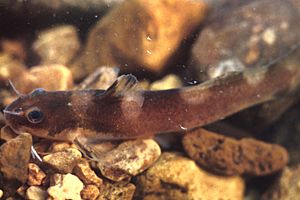Saddled madtom facts for kids
Quick facts for kids Saddled madtom |
|
|---|---|
 |
|
| Conservation status | |
| Scientific classification |
The saddled madtom (Noturus fasciatus) is a special kind of freshwater fish. It is quite rare and lives only in the state of Tennessee, USA. Scientists first officially named it as its own species in 2005. Before that, it was thought to be the same as another fish called the Chucky madtom.
This small fish mostly lives in the Duck River system. You can also find it in two smaller streams that flow into the lower Tennessee River. Saddled madtoms like to live in small to medium-sized streams. They hide under gravel, rocks, and flat stones. These fish mainly eat insects like stonefly, caddisfly, and mayfly larvae.
Contents
Where the Saddled Madtom Lives
The saddled madtom is found only in the Duck River system. It also lives in two smaller streams that join the Tennessee River in western Tennessee. So far, scientists have not found this fish in any other streams or states.
Some people think this fish might live in nearby rivers too. But we need more research to be sure. For now, it is just a theory.
What the Saddled Madtom Eats and Who Eats It
Scientists have not yet studied exactly what the saddled madtom eats. But we can guess based on its close relatives. Other madtom fish that are similar, and even breed with each other, mostly eat small creatures without backbones. This means they are invertivores. They mostly eat insects like caddisfly, mayfly, and stonefly larvae.
Eating these insects means the saddled madtom might compete for food. It could be competing with other animals like salamanders and trout. The saddled madtom is a small fish. This means bigger fish can eat it. Fish like rock bass, smallmouth bass, and largemouth bass might hunt them. Other large fish that eat smaller fish, like brown trout, could also be predators.
Madtoms have a cool way to protect themselves. They can release a special venom! This venom comes from glands near their back and side fins. It is meant to hurt predators and keep the madtom safe. Another way they stay safe is by hiding. They live in fast-moving parts of streams called "riffles," under gravel and rocks.
Saddled Madtom Life Cycle and Reproduction
Scientists have not studied the saddled madtom enough to know everything about its life. We do not know exactly when or how often it breeds. We also do not know how long it takes to become an adult or how long it lives.
But we can learn from its close relatives. Fish like the Elegant madtom, Chucky madtom, and baileyi madtom are similar. Based on these relatives, the saddled madtom likely breeds between late May and August. They probably lay their eggs on rocks and gravel at the bottom of the stream.
A female saddled madtom might lay around 50 eggs at a time. They likely live for about two years. They probably become old enough to breed after their first year of life.
Humans can affect these fish. Building dams stops the fish from moving freely in the river. Also, dirt washing into the water (erosion) and pollution from farms can hurt the fish.
Protecting the Saddled Madtom
As of 2011, there were no special plans to protect the saddled madtom. This fish is currently listed as "imperiled." This means it is in danger of disappearing. Scientists believe its numbers are going down. This is mainly because of pollution, erosion, and too much dirt in the water.
Froese, Rainer and Pauly, Daniel, eds. (2014). "Noturus fasciatus" in FishBase. May 2014 version.
See also
 In Spanish: Noturus fasciatus para niños
In Spanish: Noturus fasciatus para niños


